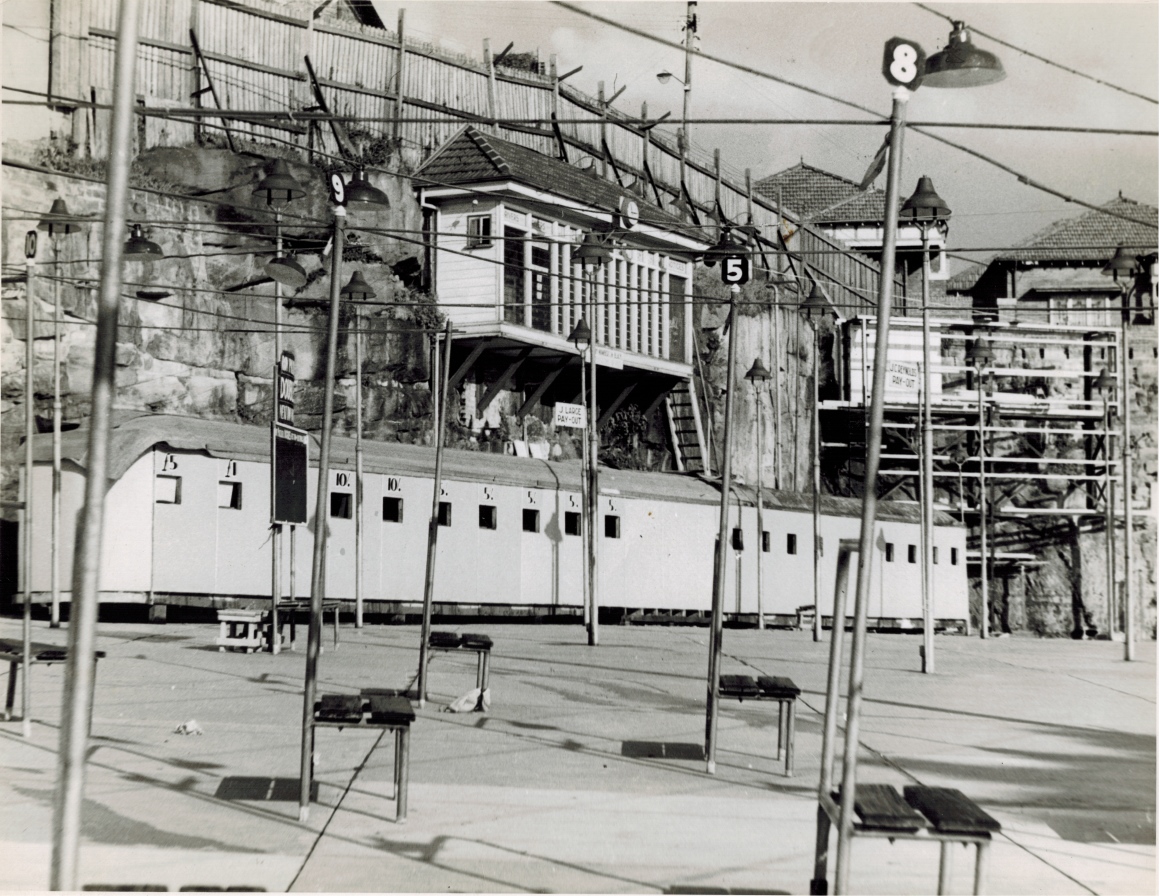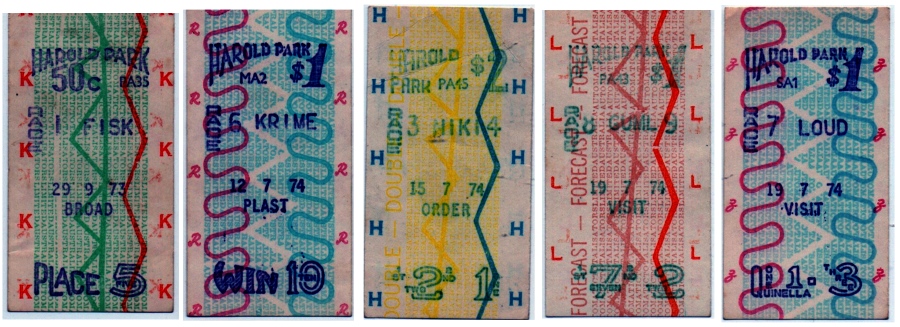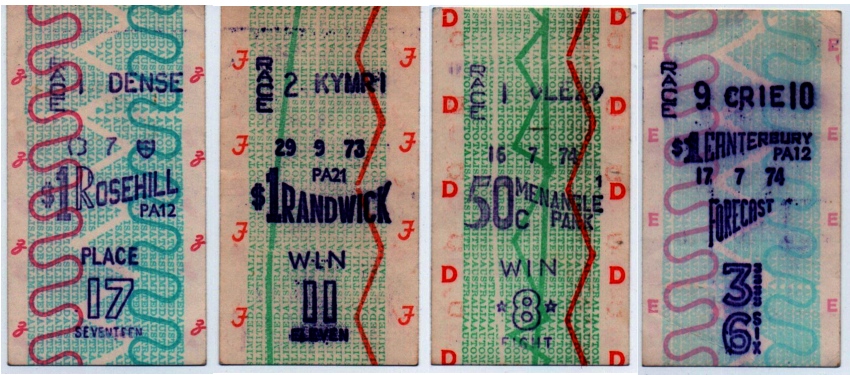
Click on the image to go back to the Photo Gallery
Following is some information from a long serving NSW Operations Manager of Automatic Totalisators, David Hamilton. He is an expert on Harold Park as this was one of the tracks under his control. David had a nickname in Automatic Totalisators, Commander Hamilton. I think there were many like me who had no idea of the origin of this nickname. I recently discovered that David indeed was a Commander, having attained that rank during a distinguished career in the Royal Navy. David was one of the early ATL managers I met after joining Automatic Totalisators and we quickly determined we shared a passion for aviation. I recall multiple interesting conversations, when David shared his experiences as a pilot, associated with aircraft carrier operations. I had read and heard about the aviation difficulties associated with operating from a moving runway at sea. I recently (2014) felt very privileged when David gave me a copy of a large book titled CARRIER A Century of First-Hand Accounts of Naval Operations in War and Peace. It was not until I started to read this very interesting book that I realised that David had written segments of the book. I eventually discovered that the book was actually dedicated to him. I have never met anyone more modest!
An extract from David's first email regarding this image reads: Harold Park - that picture was taken about the year I was born!! The back building has scaffolding. The tote house was built of tramcars - see curved roof and curved end, and judging by the cliff was actually in the old tram terminal.
More after the image.

After I enquired about the tram terminal David replied: Yes there was a large tram depot and even when I was there, 1970 onwards it was still there falling to bits, still had big sheds etc and cut off from Harold Park trots which must have taken the better area as there were no huge cliffs but a hill outside one section. A bookie parked in the road there and one day was held up by a bloke with a shot gun and robbed of his takings---this in days before the regular use of guns.
Following is some of Neville Mitchell's recollections of Harold Park. Neville is the best Automatic Totalisators historian I know:
Thanks for the photo of the original paddock A tote house. I do recall seeing this set using the old tram cars as the housings. I went there with Peter Rolls & Joe Norris to be shown the plans for the new grandstand and the construction of a new tote house along the cliff face. The indicator building atop of the trams became the W & P & Quinella tote dividend display in a 3 x 4 matrix for being televised on the CCTV system that was installed with the PDP11 tote years later. My private contracting company got the job of restoring all of the indicator lamp boxes, adding a decimal point lamp to the two & 1/2 digits display. The relays were the American Clare type extremely rugged, never needed any maintenance. I worked with Peter Rolls on the upgrade to PDP11 , AWA supplied the CCTV distribution equipment ATL did the installation. The CCTV camera that was focused on the Paddock A indicator faced due east, the camera was contained in a weatherproof housing with a sun-shield that was to prevent the rising sun from destroying the Plumbicon imaging tube. One night I forgot to close the sun-shield, I awoke at 3 AM and had to dash all the way to Harold Park to close the shade before the sun rose over the Cliff face.
The installation of the PDP11 system went very well, not many problems with the system or the track, J11 TIM's were an excellent machine. The only design change was the Circuit Breakers for the TIM's. Peter Rolls had been conned into using breakers with nil time delay. On the first full load test all the breakers switched off on the Start Betting bell, when all of the issuers started at once. We had to quickly bridge out the breakers to finish the testing. I tried these breakers. They were so fast, when I shorted out the 50 VDC line with my calibrated screwdriver I could not see the spark!!
One of Sydney's bigger Tram maintenance & Storage Depots was next door to Harold park. Many trams were stored there after the trams were abandoned unfortunately they were all destroyed by fire. The area was then turned into the headquarters of CHEP (Commonwealth Hire Equipment Pool) Making and supplying transport pallets.
The whole of Harold Park has now been razed in preparation for the construction of 1,200 high rise units. Wentworth Park Greyhound track looks like going the same way soon. The old trams were also used at Rosehill Race Track, two trams divided the Leger from the Paddock. There were J 8's facing each side, I installed multi impulse sets in the trams. As tote houses go they were not too bad. When I first worked there the track was as David describes it. The Tote machine room was "Underground" humid and smelly, mould everywhere. A Ford V8 engine provided auxiliary power, it was located at the far end of the tote machine room Noisy and hot!! The pervading smell on race night was from the adjacent Goldstein's kitchens cooking curried prawns and rice.
Thinking more about the CCTV system installation, the ledger tote was located on the far western side of the trotting track and there was ample armoured cable to allow the connection of the J11 Terminals, however there was no budget for a Co-axial cable to provide W P Q &D results to the pay clerks. We decided to try to emulate a co-axial cable by selecting just one conductor in a 50 core armour cable and then connecting the remaining conductors together to make a sort of shielded cable, we were very sceptical of the CCTV signal even getting across the track some 250 metres. I eventually hauled a Monitor over to the Leger tote and jerry rigged it to the shielded cable. To my surprise the picture was "Acceptable" in that you could clearly read the figures although there was a fair amount of snow on the picture.
Much later in the life of the Monochrome CCTV system a problem arose. The system would operate for the race meeting, then a week later when switched on for testing the Distribution Amplifiers were dead. No apparent cause could be detected just that it had to be some type of voltage surge induced into the co-axial cables. This was proven by disconnecting the cables after each race meeting. Val Adams asked me for a solution to the onerous late night task of disconnecting many cables in various places around the track. I decided the best way to control any surge was to ground all the video cables using good old relays. A central coaxial cable panel was designed with the relays suitably placed with short stout wiring to connect the system, to a system ground, when not in use. It was a bugger of an installation as each RG85 coaxial cable had to be cut and a new PL259 coaxial connector fitted to each end, then plugged into the new Isolation/grounding panel. The system worked very well and did not require any intervention by the staff, as it was automatically enabled when the CCTV distribution rack was turned on.
Sydney Racecourse Management's David Hamilton, was always appreciative of the advice and assistance I gave when asked. A couple of times a year my family were treated as guests in the company box. I never received an account for the "Consumables". It was a good chance for me to show what my work was all about. Tours of the computer room went down well with prospective sons in-laws.
So ends Neville's recollections. I too remember Harold Park. When I joined Automatic Totalisators, I was competent in the subjects of Mini Computer Engineering and Electronics but knew nothing of Totalisator Operations. I was sent to see an operation at Harold Park to start my induction training. My wife and I attended an operation at Harold Park, where I met David Hamilton who gave me a good introduction to these systems and their operation and was very welcoming. It did not take long for David and I to realise we shared a passion, aviation, as he was an ex Royal Navy Pilot and I was a part time pilot. I was living in Sydney at the time and after I moved to Brisbane with the Brisbane Project and the PDP11 systems that replaced the Julius totes there, I often had business trips to Sydney. I recall on a few occasions being unofficially asked by Del Elliott who had a senior position with ATL at Harold Park to have a look at some recurring, elusive problems with the PDP11 system. I think they all turned out to be intermittent disk problems. It is interesting to note that Del's son Gary Elliott became the Tote Manager of Harold Park. Gary's predominant roles in the company were Tote Engineer and Project Manager spending much of his time overseas. Gary was the epitome of a pervading company ethos, in doing whatever it takes to get the job done properly.
Chris Robertson provided the following Harold Park ticket images which were purchased here whilst David Hamilton mentioned above was the NSW Operations Manager.
 Chris Robertson's Harold Park Tickets
Chris Robertson's Harold Park Tickets
Chris wrote the following about the PDP8 based totalisator at Harold Park which produced the above tickets:
The tote at Harold Park and Wentworth Park was world's best. Instantaneous updates of Win,Place and Quinellas on electronic indicator boards was well in advance of what was available in Melbourne in the early 1970's. Even after the Melbourne race clubs computerised the tote in Spring 1974, the Harold Park and Wentworth Park totes were still offering a superior service in the display of betting odds.
Neville mentions Rosehill in his recollections above which is where the left hand ticket in the image below comes from.
Chris made the following comment about the tickets below:
Sydney J8 & J10 (TIMs). The iconic ATL tickets of the era. The Menangle ticket was purchased from a tote mobile. Menangle was then the number two NSW Trotting Club track. With the closure of Harold Park, the rebuilt Tabcorp Park Menangle is Australia's premier harness racing track.
Chris Robertson's NSW Tickets
